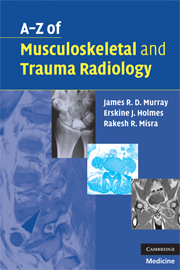Book contents
- Frontmatter
- Contents
- Acknowledgements
- Preface
- List of abbreviations
- Section I Musculoskeletal radiology
- Section II Trauma radiology
- ATLS – Advanced Trauma Life Support
- Acetabular fractures
- Aortic rupture
- Cervical spine injury
- Flail chest
- Haemothorax
- Open fractures
- Pelvic fracture
- Peri-physeal injury
- Pneumothorax
- Rib/sternal fracture
- Skull fracture
- Thoraco-lumbar spine fractures
- Acromioclavicular joint injury
- Carpal dislocation and instability
- Clavicular fractures
- Elbow injuries and distal humeral fractures
- Hand injuries – general principles
- Hand injuries – specific examples
- Thumb metacarpal fractures
- Humerus fracture – proximal fractures
- Humerus fracture – shaft fractures
- Humerus fracture – supracondylar fractures – paediatric
- Radius fracture – head of radius fractures
- Radius fracture – shaft fractures
- Galeazzi fracture dislocation
- Radius fracture – distal radial fractures
- Related wrist fractures
- Scaphoid fracture
- Scapular fracture
- Shoulder dislocation
- Ulna fracture – proximal and olecranon fractures
- Ulna fracture – shaft fractures
- Monteggia fracture dislocation
- Accessory ossicles of the foot
- Ankle fractures
- Bone bruising
- Calcaneal (Os calcis) fractures
- Femoral neck fracture
- Femoral shaft fracture
- Femoral supracondylar fracture
- Hip dislocation – traumatic
- Knee soft-tissue injury
- Metatarsal fractures – commonly fifth MT base
- Patella fracture
- Tibial-plateau fracture
- Tibial-shaft fractures
- Tibial-plafond (Pilon) fractures
- Talus fractures/dislocations
Humerus fracture – proximal fractures
from Section II - Trauma radiology
Published online by Cambridge University Press: 22 August 2009
- Frontmatter
- Contents
- Acknowledgements
- Preface
- List of abbreviations
- Section I Musculoskeletal radiology
- Section II Trauma radiology
- ATLS – Advanced Trauma Life Support
- Acetabular fractures
- Aortic rupture
- Cervical spine injury
- Flail chest
- Haemothorax
- Open fractures
- Pelvic fracture
- Peri-physeal injury
- Pneumothorax
- Rib/sternal fracture
- Skull fracture
- Thoraco-lumbar spine fractures
- Acromioclavicular joint injury
- Carpal dislocation and instability
- Clavicular fractures
- Elbow injuries and distal humeral fractures
- Hand injuries – general principles
- Hand injuries – specific examples
- Thumb metacarpal fractures
- Humerus fracture – proximal fractures
- Humerus fracture – shaft fractures
- Humerus fracture – supracondylar fractures – paediatric
- Radius fracture – head of radius fractures
- Radius fracture – shaft fractures
- Galeazzi fracture dislocation
- Radius fracture – distal radial fractures
- Related wrist fractures
- Scaphoid fracture
- Scapular fracture
- Shoulder dislocation
- Ulna fracture – proximal and olecranon fractures
- Ulna fracture – shaft fractures
- Monteggia fracture dislocation
- Accessory ossicles of the foot
- Ankle fractures
- Bone bruising
- Calcaneal (Os calcis) fractures
- Femoral neck fracture
- Femoral shaft fracture
- Femoral supracondylar fracture
- Hip dislocation – traumatic
- Knee soft-tissue injury
- Metatarsal fractures – commonly fifth MT base
- Patella fracture
- Tibial-plateau fracture
- Tibial-shaft fractures
- Tibial-plafond (Pilon) fractures
- Talus fractures/dislocations
Summary
Characteristics
Common in the elderly osteoporotic population following a fall onto the outstretched hand.
In the general population requires a more significant force, unless metastatic deposits are present in the proximal humerus.
Depending on the forces applied, dislocation can occur concomitantly.
Classified by Neer depending on the number and displacement of segments. The four segments described are: head, greater tuberosity, lesser tuberosity and shaft. Displacement is defined as separation of > 1 cm or > 45 degrees of angulation.
Clinical features
The patient will complain of pain and be reluctant to move the arm, often supporting the elbow with the contralateral hand.
Deformity may be present with associated bruising and/or fracture crepitus.
Check and document axillary-nerve sensorimotor function – look/feel for a flicker of isometric deltoid contraction by asking the patient to try and abduct their arm, but with the examiner's hands stabilising the humerus so no movement occurs, thus minimising pain.
Radiological features
AP gleno-humeral joint and axillary view is the best combination; however in the acute situation a Velpeau view (oblique axial view with the patient leaning backwards over the film and the arm abducted, e.g. holding an i.v. pole on the trolley) is far more useful than a lateral scapular ‘guessogram’.
Fracture line should be assessed according to Neer's classification.
A lipo-haemarthrosis may be visible as a fat/fluid level inferior to the acromium.
A significant haemarthrosis may displace the humeral head downwards resulting in a pseudo-subluxation – this is exacerbated by the lack of deltoid tone to minimise pain.
Look for associated dislocation (anterior or posterior) – best seen on the axial/axillary view – look for the corAcoid to orient Anterior.
- Type
- Chapter
- Information
- A-Z of Musculoskeletal and Trauma Radiology , pp. 251 - 253Publisher: Cambridge University PressPrint publication year: 2008



